Low-Dimensional Nanostructures Based on Cobalt Oxide (Co3O4) in Chemical-Gas Sensing
Abstract
1. Introduction
2. Material and Sensing
2.1. Characteristics Properties of a Chemical/Gas Sensor
2.2. Conducting Mechanism of Chemical/Gas Sensor
- Metal to semiconductor;
- Outer conductive and narrow accumulation layers at the surface of the nanowire;
- Narrow accumulation layers at the surface of the grains and broad bulk of the nanowire;
- Nanowire to nanowire.
3. Growth Techniques of 1D Nano Structures of the Co3O4
3.1. Hydrothermal and Solvothermal Techniques
3.2. Electrospinning Techniques
4. Overview of Reported 1 D Nano Structured Co3O4 Gas Sensors
4.1. Sensing toward Ethanol (C2H5OH)
4.2. Sensing toward Acetone (C3H6O)
4.3. Sensing toward Carbon Monoxide (CO)
4.4. Sensing toward Toluene (C7H8) and Xylene (C8H10)
4.5. Sensing toward Ammonia (NH3)
4.6. Detection toward Hydrogen Sulfide (H2S)
4.7. Sensing toward Diethyl Ether (C4H10O, DEE)
4.8. Sensing toward Formaldehyde (HCHO)
4.9. Sensing toward Dimethyl Methylphosphonate (C3H9O3P, DMMP)
4.10. Sensing toward Triethylamine (C6H15N, TEA)
5. Conclusions and Outlook
Author Contributions
Funding
Institutional Review Board Statement
Informed Consent Statement
Data Availability Statement
Conflicts of Interest
References
- Hulanicki, A.; Glab, S.; Ingman, F. Chemical Sensors: Definitions and Classification. Pure Appl. Chem. 1991, 63, 1247–1250. [Google Scholar] [CrossRef]
- Qiao, X.; Xu, Y.; Yang, K.; Ma, J.; Li, C.; Wang, H.; Jia, L. Mo Doped BiVO4 Gas Sensor with High Sensitivity and Selectivity Towards H2S. Chem. Eng. Sci. 2020, 395, 125144. [Google Scholar] [CrossRef]
- Choi, K.; Kim, H.; Kim, K.; Liu, D.; Cao, G.; Lee, J. C2H5OH Sensing Characteristics of Various Co3O4 Nanostructures Prepared by Solvothermal Reaction. Sens. Actuators B Chem. 2010, 146, 183–189. [Google Scholar] [CrossRef]
- Aqeel, T.; Galstyan, V.; Comini, E. Mesoporous Polycrystalline SnO2 Framework Synthesized by Direct Soft Templating Method for Highly Selective Detection of NO2. Nanotechnology 2019, 31, 105502. [Google Scholar] [CrossRef] [PubMed]
- Comini, E. Metal Oxide Nano-Crystals for Gas Sensing. Anal. Chim. Acta 2006, 568, 28–40. [Google Scholar] [CrossRef] [PubMed]
- Comini, E.; Yubao, L.; Brando, Y.; Sberveglieri, G. Gas Sensing Properties of MoO3 Nanorods to CO and CH3OH. Chem. Phys. Lett. 2005, 407, 368–371. [Google Scholar] [CrossRef]
- Wong, Y.; Ang, B.; Haseeb, A.; Baharuddin, A.; Wong, Y. Review—Conducting Polymers as Chemiresistive Gas Sensing Materials: A Review. J. Electrochem. Soc. 2019, 167, 037503. [Google Scholar] [CrossRef]
- Husain, A.; Ahmad, S.; Mohammad, F. Synthesis, Characterisation and Ethanol Sensing Application of Polythiophene/Graphene Nanocomposite. Mater. Chem. Phys. 2020, 239, 122324. [Google Scholar] [CrossRef]
- Guo, Z.; Liao, N.; Zhang, M.; Feng, A. Enhanced Gas Sensing Performance of Polyaniline Incorporated with Graphene: A First-Principles Study. Phys. Lett. A 2019, 383, 2751–2754. [Google Scholar] [CrossRef]
- Reddeppa, M.; Chandrakalavathi, T.; Park, B.; Murali, G.; Siranjeevi, R.; Nagaraju, G.; Su Yu, J.; Jayalakshmi, R.; Kim, S.; Kim, M. UV-Light Enhanced CO Gas Sensors Based on Ingan Nanorods Decorated With P-Phenylenediamine-Graphene Oxide Composite. Sens. Actuators B Chem. 2020, 307, 127649. [Google Scholar] [CrossRef]
- Harraz, F.; Faisal, M.; Jalalah, M.; Almadiy, A.; Al-Sayari, S.; Al-Assiri, M. Conducting Polythiophene/A-Fe2O3 Nanocomposite for Efficient Methanol Electrochemical Sensor. Appl. Surf. Sci. 2020, 508, 145226. [Google Scholar] [CrossRef]
- Choi, J.; Hwang, I.; Kim, S.; Park, J.; Park, S.; Jeong, U.; Kang, Y.; Lee, J. Design of Selective Gas Sensors Using Electrospun Pd-Doped SnO2 Hollow Nanofibers. Sens. Actuators B Chem. 2010, 150, 191–199. [Google Scholar] [CrossRef]
- Wang, C.; Yin, L.; Zhang, L.; Xiang, D.; Gao, R. Metal Oxide Gas Sensors: Sensitivity and Influencing Factors. Sensors 2010, 10, 2088–2106. [Google Scholar] [CrossRef] [PubMed]
- Kim, H.; Lee, J. Highly Sensitive and Selective Gas Sensors Using P-Type Oxide Semiconductors: Overview. Sens. Actuators B Chem. 2014, 192, 607–627. [Google Scholar] [CrossRef]
- Patil, D.; Patil, P.; Subramanian, V.; Joy, P.; Potdar, H. Highly Sensitive and Fast Responding CO Sensor Based on Co3O4 Nanorods. Talanta 2010, 81, 37–43. [Google Scholar] [CrossRef] [PubMed]
- Dou, Z.; Cao, C.; Chen, Y.; Song, W. Fabrication of Porous Co3O4 nanowires with High CO Sensing Performance at A Low Operating Temperature. Chem. Commun. 2014, 50, 14889–14891. [Google Scholar] [CrossRef] [PubMed]
- Zhang, X.; Wang, J.; Xuan, L.; Zhu, Z.; Pan, Q.; Shi, K.; Zhang, G. Novel Co3O4 Nanocrystalline Chain Material as A High Performance Gas Sensor at Room Temperature. J. Alloy. Compd. 2018, 768, 190–197. [Google Scholar] [CrossRef]
- Tan, J.; Dun, M.; Li, L.; Zhao, J.; Tan, W.; Lin, Z.; Huang, X. Synthesis of Hollow and Hollowed-Out Co3O4 Microspheres Assembled by Porous Ultrathin Nanosheets For Ethanol Gas Sensors: Responding and Recovering in One Second. Sens. Actuators B Chem. 2017, 249, 44–52. [Google Scholar] [CrossRef]
- Tan, W.; Tan, J.; Li, L.; Dun, M.; Huang, X. Nanosheets-Assembled Hollowed-Out Hierarchical Co3O4 Microrods For Fast Response/Recovery Gas Sensor. Sens. Actuators B Chem. 2017, 249, 66–75. [Google Scholar] [CrossRef]
- Yuan, Y.; Wang, Y.; He, X.; Chen, M.; Liu, J.; Liu, B.; Zhao, H.; Liu, S.; Yang, H. Increasing Gas Sensitivity of Co3O4 Octahedra by Tuning Co-Co3O4 (111) Surface Structure and Sensing Mechanism of 3-Coordinated Co Atom as An Active Center. J. Mater. Sci.: Mater. Electron. 2020, 31, 8852–8864. [Google Scholar] [CrossRef]
- Zhou, Q.; Zeng, W. Shape Control of Co3O4 Micro-Structures for High-Performance Gas Sensor. Phys. E Low Dimens. Syst. Nanostruct. 2018, 95, 121–124. [Google Scholar] [CrossRef]
- Xu, K.; Yu, X.; Zhao, W.; Zeng, W. Density-Dependent of Gas-Sensing Properties of Co3O4 Nanowire Arrays. Phys. E Low Dimens. Syst. Nanostruct. 2020, 118, 113956. [Google Scholar] [CrossRef]
- Kozlovskiy, A.; Zdorovets, M. The Study of The Structural Characteristics and Catalytic Activity of Co/CoCo2O4 Nanowires. Compos. B. Eng. 2020, 191, 107968. [Google Scholar] [CrossRef]
- Nguyen, H.; El-Safty, S. Meso and Macroporous Co3O4 Nanorods for Effective VOC Gas Sensors. J. Phys. Chem. C 2011, 115, 8466–8474. [Google Scholar] [CrossRef]
- Wen, Z.; Zhu, L.; Mei, W.; Hu, L.; Li, Y.; Sun, L.; Cai, H.; Ye, Z. Rhombus-Shaped Co3O4 Nanorod Arrays for High-Performance Gas Sensor. Sens. Actuators B Chem. 2013, 186, 172–179. [Google Scholar] [CrossRef]
- Wang, S.; Cao, J.; Cui, W.; Fan, L.; Li, X.; Li, D.; Zhang, T. One-Dimensional Porous Co3O4 Rectangular Rods for Enhanced Acetone Gas Sensing Properties. Sens. Actuators B Chem. 2019, 297, 126746. [Google Scholar] [CrossRef]
- Wang, L.; Deng, J.; Lou, Z.; Zhang, T. Nanoparticles-Assembled Co3O4 Nanorods P-Type Nanomaterials: One-Pot Synthesis and Toluene-Sensing Properties. Sens. Actuators B Chem. 2014, 201, 1–6. [Google Scholar] [CrossRef]
- Vetter, S.; Haffer, S.; Wagner, T.; Tiemann, M. Nanostructured Co3O4 as a CO Gas Sensor: Temperature-Dependent Behavior. Sens. Actuators B Chem. 2015, 206, 133–138. [Google Scholar] [CrossRef]
- Jiang, R.; Jia, L.; Guo, X.; Zhao, Z.; Du, J.; Wang, X.; Wang, P.; Xing, F. Dimethyl Sulfoxide-Assisted Hydrothermal Synthesis of Co3O4-Based Nanorods For Selective and Sensitive Diethyl Ether Sensing. Sens. Actuators B Chem. 2019, 290, 275–284. [Google Scholar] [CrossRef]
- Deng, S.; Liu, X.; Chen, N.; Deng, D.; Xiao, X.; Wang, Y. A Highly Sensitive VOC Gas Sensor Using P-Type Mesoporous Co3O4 Nanosheets Prepared by A Facile Chemical Coprecipitation Method. Sens. Actuators B Chem. 2016, 233, 615–623. [Google Scholar] [CrossRef]
- Zhang, Z.; Wen, Z.; Ye, Z.; Zhu, L. Gas Sensors Based on Ultrathin Porous Co3O4 Nanosheets to Detect Acetone at Low Temperature. RSC Adv. 2015, 5, 59976–59982. [Google Scholar] [CrossRef]
- Lü, Y.; Zhan, W.; He, Y.; Wang, Y.; Kong, X.; Kuang, Q.; Xie, Z.; Zheng, L. MOF-Templated Synthesis of Porous Co3O4 Concave Nanocubes with High Specific Surface Area and Their Gas Sensing Properties. ACS Appl. Mater. Interfaces 2014, 6, 4186–4195. [Google Scholar] [CrossRef]
- Cao, J.; Wang, S.; Zhao, X.; Xing, Y.; Li, J.; Li, D. Facile synthesis and enhanced toluene gas sensing performances of Co3O4 hollow nanosheets. Mater. Lett. 2020, 263, 127215. [Google Scholar] [CrossRef]
- Wen, Z.; Zhu, L.; Li, Y.; Zhang, Z.; Ye, Z. Mesoporous Co3O4 Nanoneedle Arrays for High-Performance Gas Sensor. Sens. Actuators B Chem. 2014, 203, 873–879. [Google Scholar] [CrossRef]
- Park, J.; Shen, X.; Wang, G. Solvothermal Synthesis and Gas-Sensing Performance of Co3O4 Hollow Nanospheres. Sens. Actuators B Chem. 2009, 136, 494–498. [Google Scholar] [CrossRef]
- Shen, S.; Xu, M.; Lin, D.; Pan, H. The Growth of Urchin-Like Co3O4 Directly on Sensor Substrate and Its Gas Sensing Properties. Appl. Surf. Sci. 2017, 396, 327–332. [Google Scholar] [CrossRef]
- Li, C.; Yin, X.; Wang, T.; Zeng, H. Morphogenesis of Highly Uniform CoCo3 Submicrometer Crystals and Their Conversion to Mesoporous for Gas-Sensing Applications. Chem. Mater. 2009, 21, 4984–4992. [Google Scholar] [CrossRef]
- Deng, S.; Chen, N.; Deng, D.; Li, Y.; Xing, X.; Wang, Y. Meso and Macroporous Coral-Like Co3O4 for VOCs Gas Sensor. Ceram. Int. 2015, 41, 11004–11012. [Google Scholar] [CrossRef]
- Lee, J. Gas Sensors Using Hierarchical and Hollow Oxide Nanostructures: Overview. Sens. Actuators B Chem. 2009, 140, 319–336. [Google Scholar] [CrossRef]
- Xu, J.; Zhang, Y.; Chen, Y.; Xiang, Q.; Pan, Q.; Shi, L. Uniform ZnO Nanorods Can be Used to Improve the Response of ZnO Gas Sensor. Mater. Sci. Eng. B 2008, 150, 55–60. [Google Scholar] [CrossRef]
- Xu, J.; Wang, D.; Qin, L.; Yu, W.; Pan, Q. SnO2 Nanorods and Hollow Spheres: Controlled Synthesis and Gas Sensing Properties. Sens. Actuators B Chem. 2009, 137, 490–495. [Google Scholar] [CrossRef]
- Wang, L.; Song, S.Y.; Hong, B.; Xu, J.C.; Han, Y.B.; Jin, H.X.; Jin, D.F.; Li, J.; Yang, Y.T.; Peng, X.L.; et al. Highly improved toluene gas-sensing performance of mesoporous Co3O4 nanowires and physical mechanism. Mater. Res. Bull 2021, 140, 111329. [Google Scholar] [CrossRef]
- Qiao, X.; Ma, C.; Chang, X.; Li, X.; Li, K.; Zhu, L.; Xia, F.; Xue, Q. 3D radial Co3O4 nanorod cluster derived from cobalt-based layered hydroxide metal salt for enhanced trace acetone detection. Sens. Actuators B Chem. 2021, 324, 128926. [Google Scholar] [CrossRef]
- Xu, J.; Cheng, J. The Advances of Co3O4 as Gas Sensing Materials: A Review. J. Alloy. Compd. 2016, 686, 753–768. [Google Scholar] [CrossRef]
- Chen, J.; Wu, X.; Selloni, A. Electronic structure and bonding properties of cobalt oxide in the spinel structure. Phys. Rev. B. 2011, 83, 245204. [Google Scholar] [CrossRef]
- Kaur, N.; Singh, M.; Moumen, A.; Duina, G.; Comini, E. 1D Titanium Dioxide: Achievements in Chemical Sensing. Materials 2020, 13, 2974. [Google Scholar] [CrossRef]
- Bagga, S.; Akhtar, J.; Mishra, S. Synthesis and Applications of ZnO Nanowire: A Review. AIP Conf. Proc. 2018, 1989, 020004. [Google Scholar] [CrossRef]
- Moseley, P. Progress in the Development of Semiconducting Metal Oxide Gas Sensors: A Review. Meas. Sci. Technol. 2017, 28, 082001. [Google Scholar] [CrossRef]
- Barsan, N.; Simion, C.; Heine, T.; Pokhrel, S.; Weimar, U. Modeling of Sensing and Transduction for P-Type Semiconducting Metal Oxide Based Gas Sensors. J. Electroceram. 2009, 25, 11–19. [Google Scholar] [CrossRef]
- Barsan, N.; Weimar, U. Conduction Model of Metal Oxide Gas Sensors. J. Electroceram. 2001, 7, 143–167. [Google Scholar] [CrossRef]
- Mijatovic, D.; Eijkel, J.; van den Berg, A. Technologies for Nanofluidic Systems: Top-Down vs. Bottom-Up—A Review. Lab Chip 2005, 5, 492. [Google Scholar] [CrossRef]
- Cao, J.; Wang, S.; Zhang, H.; Zhang, T. Constructing One Dimensional Co3O4 Hierarchical Nanofibers as Efficient Sensing Materials for Rapid Acetone Gas Detection. J. Alloy. Compd. 2019, 799, 513–520. [Google Scholar] [CrossRef]
- Deng, J.; Zhang, R.; Wang, L.; Lou, Z.; Zhang, T. Enhanced Sensing Performance of The Co3O4 Hierarchical Nanorods To NH3 Gas. Sens. Actuators B Chem. 2015, 209, 449–455. [Google Scholar] [CrossRef]
- George, G.; Anandhan, S. Tuning Characteristics of Co3O4 Nanofiber Mats Developed for Electrochemical Sensing of Glucose and H2O2. Thin Solid Films 2016, 610, 48–57. [Google Scholar] [CrossRef]
- Sun, C.; Su, X.; Xiao, F.; Niu, C.; Wang, J. Synthesis of Nearly Monodisperse Co3O4 Properties. Sens. Actuators B Chem. 2011, 157, 681–685. [Google Scholar] [CrossRef]
- Xu, K.; Zou, J.; Tian, S.; Yang, Y.; Zeng, F.; Yu, T.; Zhang, Y.; Jie, X.; Yuan, C. Single-Crystalline Porous Nanosheets Assembled Hierarchical Co3O4 Microspheres for Enhanced Gas-Sensing Properties to Trace Xylene. Sens. Actuators B Chem. 2017, 246, 68–77. [Google Scholar] [CrossRef]
- Feng, S.; Li, G. Hydrothermal and Solvothermal Syntheses. In Modern Inorganic Synthetic Chemistry, 2nd ed.; Xu, R., Xu, R., Eds.; John Fedor: Cambridge, CA, USA, 2017; pp. 73–104. [Google Scholar] [CrossRef]
- Wang, X.; Hu, A.; Meng, C.; Wu, C.; Yang, S.; Hong, X. Recent Advance in Co3O4 and Co3O4-Containing Electrode Materials for High-Performance Supercapacitors. Molecules 2020, 25, 269. [Google Scholar] [CrossRef] [PubMed]
- Jeong, H.; Kim, H.; Rai, P.; Yoon, J.; Lee, J. Cr-Doped Co3O4 Nanorods as Chemiresistor for Ultraselective Monitoring of Methyl Benzene. Sens. Actuators B Chem. 2014, 201, 482–489. [Google Scholar] [CrossRef]
- Koo, A.; Yoo, R.; Woo, S.; Lee, H.; Lee, W. Enhanced Acetone-Sensing Properties of Pt-Decorated Al-Doped Zno Nanoparticles. Sens. Actuators B Chem. 2019, 280, 109–119. [Google Scholar] [CrossRef]
- Bhardwaj, N.; Kundu, S. Electrospinning: A Fascinating Fiber Fabrication Technique. Biotechnol. Adv. 2010, 28, 325–347. [Google Scholar] [CrossRef]
- Busacca, C.; Donato, A.; Lo Faro, M.; Malara, A.; Neri, G.; Trocino, S. CO Gas Sensing Performance of Electrospun Co3O4 Nanostructures at Low Operating Temperature. Sens. Actuators B Chem. 2020, 303, 127193. [Google Scholar] [CrossRef]
- Yoon, J.; Kim, H.; Jeong, H.; Lee, J. Gas Sensing Characteristics of P-Type Cr2O3 and Co3O4 Nanofibers Depending on Inter-Particle Connectivity. Sens. Actuators B Chem. 2014, 202, 263–271. [Google Scholar] [CrossRef]
- Shankar, P.; Bosco, J.; Rayappan, B. Gas sensing mechanism of metal oxides: The role of ambient atmosphere, type of semiconductor and gases—A review. Sci. Jet 2015, 4, 126. [Google Scholar]
- Yoon, J.; Choi, J.; Lee, J. Design of a Highly Sensitive and Selective C2H5OH Sensor Using P-Type Co3O4 Nanofibers. Sens. Actuators B Chem. 2012, 161, 570–577. [Google Scholar] [CrossRef]
- Choi, S.; Ryu, W.; Kim, S.; Cho, H.; Kim, I. Bi-Functional Co-Sensitization of Graphene Oxide Sheets and Ir Nanoparticles on P-Type Co3O4 Nanofibers for Selective Acetone Detection. J. Mater. Chem. B 2014, 2, 7160–7167. [Google Scholar] [CrossRef] [PubMed]
- Qu, F.; Feng, C.; Li, C.; Li, W.; Wen, S.; Ruan, S.; Zhang, H. Preparation and Xylene-Sensing Properties of Co3O4 nanofibers. Int. J. Appl. Ceram. Technol. 2013, 11, 619–625. [Google Scholar] [CrossRef]
- Shin, J.; Choi, S.; Youn, D.; Kim, I. Exhaled Vocs Sensing Properties of WO3 Nanofibers Functionalized by Pt and IrO2 Nanoparticles for Diagnosis of Diabetes and Halitosis. J. Electroceramics 2012, 29, 106–116. [Google Scholar] [CrossRef]
- Brugha, R.; Edmondson, C.; Davies, J. Outdoor Air Pollution and Cystic Fibrosis. Paediatr. Respir. Rev. 2018, 28, 80–86. [Google Scholar] [CrossRef]
- Mirzaei, A.; Lee, J.; Majhi, S.; Weber, M.; Bechelany, M.; Kim, H.; Kim, S. Resistive Gas Sensors Based on Metal-Oxide Nanowires. J. Appl. Phys. 2019, 126, 241102. [Google Scholar] [CrossRef]
- Feng, Q.; Li, X.; Wang, J.; Gaskov, A. Reduced Graphene Oxide (RGO) Encapsulated Co3O4 Composite Nanofibers for Highly Selective Ammonia Sensors. Sens. Actuators B Chem. 2016, 222, 864–870. [Google Scholar] [CrossRef]
- Wang, M.; Zhu, Y.; Meng, D.; Wang, K.; Wang, C. A Novel Room Temperature Ethanol Gas Sensor Based on 3D Hierarchical Flower-Like TiO2 Microstructures. Mater. Lett. 2020, 277, 128372. [Google Scholar] [CrossRef]
- Thungon, P.; Kakoti, A.; Ngashangva, L.; Goswami, P. Advances in Developing Rapid, Reliable and Portable Detection Systems for Alcohol. Biosens. Bioelectron. 2017, 97, 83–99. [Google Scholar] [CrossRef] [PubMed]
- Mirzaei, A.; Janghorban, K.; Hashemi, B.; Bonyani, M.; Leonardi, S.; Neri, G. Highly Stable and Selective Ethanol Sensor Based on A-Fe2O3 Nanoparticles Prepared by Pechini Sol–Gel Method. Ceram. Int. 2016, 42, 6136–6144. [Google Scholar] [CrossRef]
- Deng, C.; Zhang, J.; Yu, X.; Zhang, W.; Zhang, X. Determination of acetone in human breath by gas chromatography–mass spectrometry and solid-phase microextraction with on-fiber derivatization. J. Chromatogr. B 2004, 810, 269–275. [Google Scholar] [CrossRef]
- Ma, H.; Xu, Y.; Rong, Z.; Cheng, X.; Gao, S.; Zhang, X.; Zhao, H.; Huo, L. Highly Toluene Sensing Performance Based on Monodispersed Cr2O3 Porous Microspheres. Sens. Actuators B Chem. 2012, 174, 325–331. [Google Scholar] [CrossRef]
- Kwak, D.; Lei, Y.; Maric, R. Ammonia gas sensors: A comprehensive review. Talanta 2019, 204, 713–730. [Google Scholar] [CrossRef]
- National Research Council. Acute Exposure Guideline Levels for Selected Airborne Chemicals; National Academies Press: Washington, DC, USA, 2008; Volume 6. [Google Scholar] [CrossRef]
- Balamurugan, C.; Lee, D. A Selective NH3 Gas Sensor Based on Mesoporous P-Type NiV2O6 Semiconducting Nanorods Synthesized Using Solution Method. Sens. Actuators B Chem. 2014, 192, 414–422. [Google Scholar] [CrossRef]
- Sun, M.; Yu, H.; Dong, X.; Xia, L.; Yang, Y. Sedum Lineare Flower-Like Ordered Mesoporous In2O3/Zno Gas Sensing Materials with high Sensitive Response to H2S at Room Temperature Prepared by Self-Assembled of 2D Nanosheets. J. Alloy. Compd. 2020, 844, 156170. [Google Scholar] [CrossRef]
- Zhong, K.; Chen, L.; Yan, X.; Tang, Y.; Hou, S.; Li, X.; Tang, L. Dual-Functional Multi-Application Probe: Rapid Detection of H2S And Colorimetric Recognition of HSO3—In Food and Cell. Dyes Pigments 2020, 182, 108656. [Google Scholar] [CrossRef]
- Quang, P.; Cuong, N.; Hoa, T.; Long, H.; Hung, C.; Le, D.; Hieu, N. Simple Post-Synthesis of Mesoporous P-Type Co3O4 Nanochains for Enhanced H2S Gas Sensing Performance. Sens. Actuators B Chem. 2018, 270, 158–166. [Google Scholar] [CrossRef]
- Song, M.; Choi, J.; Jeong, H.; Song, K.; Jeon, S.; Cha, J.; Baeck, S.; Shim, S.; Qian, Y. A Comprehensive Study of Various Amine-Functionalized Graphene Oxides for Room Temperature Formaldehyde Gas Detection: Experimental and Theoretical Approaches. Appl. Surf. Sci. 2020, 529, 147189. [Google Scholar] [CrossRef]
- Zhu, L.; Wang, J.; Liu, J.; Nasir, M.; Zhu, J.; Li, S.; Liang, J.; Yan, W. Smart Formaldehyde Detection Enabled by Metal Organic Framework-Derived Doped Electrospun Hollow Nanofibers. Sens. Actuators B Chem. 2021, 326, 128819. [Google Scholar] [CrossRef]
- Wang, S.; Xiao, C.; Wang, P.; Li, Z.; Xiao, B.; Zhao, R.; Yang, T.; Zhang, M. Co3O4 Hollow Nanotubes: Facile Synthesis and Gas Sensing Properties. Mater. Lett. 2014, 137, 289–292. [Google Scholar] [CrossRef]
- Bai, S.; Liu, H.; Sun, J.; Tian, Y.; Luo, R.; Li, D.; Chen, A. Mechanism of enhancing the formaldehyde sensing properties of Co3O4via Ag modification. RSC Adv. 2015, 5, 48619–48625. [Google Scholar] [CrossRef]
- Hurtado, I.D.; Chávarri, J.G.; Morandi, S.; Samà, J.; Rodríguez, A.R.; Castaño, E.; Mandayo, G.G. Formaldehyde sensing mechanism of SnO2 nanowires grown on-chip by sputtering techniques. RSC Adv. 2016, 6, 18558–18566. [Google Scholar] [CrossRef][Green Version]
- Yang, X.; Yu, Q.; Zhang, S.; Sun, P.; Lu, H.; Yan, X.; Liu, F.; Zhou, X.; Liang, X.; Gao, Y.; et al. Highly sensitive and selective triethylamine gas sensor based on porous SnO2/Zn2SnO4 composites. Sens. Actuators B Chem. 2018, 266, 213–220. [Google Scholar] [CrossRef]
- Alali, K.; Liu, J.; Moharram, D.; Liu, Q.; Yu, J.; Chen, R.; Li, R.; Wang, J. Fabrication of Electrospun Co3O4/CuO P-P Heterojunctions Nanotubes Functionalized with HFIP for Detecting Chemical Nerve Agent Under Visible Light Irradiation. Sens. Actuators B Chem. 2020, 314, 128076. [Google Scholar] [CrossRef]
- Gui, Y.; Tian, K.; Liu, J.; Yang, L.; Zhang, H.; Wang, Y. Superior Triethylamine Detection at Room Temperature By {-112} Faceted WO3 Gas Sensor. J. Hazard. Mater. 2019, 380, 120876. [Google Scholar] [CrossRef] [PubMed]
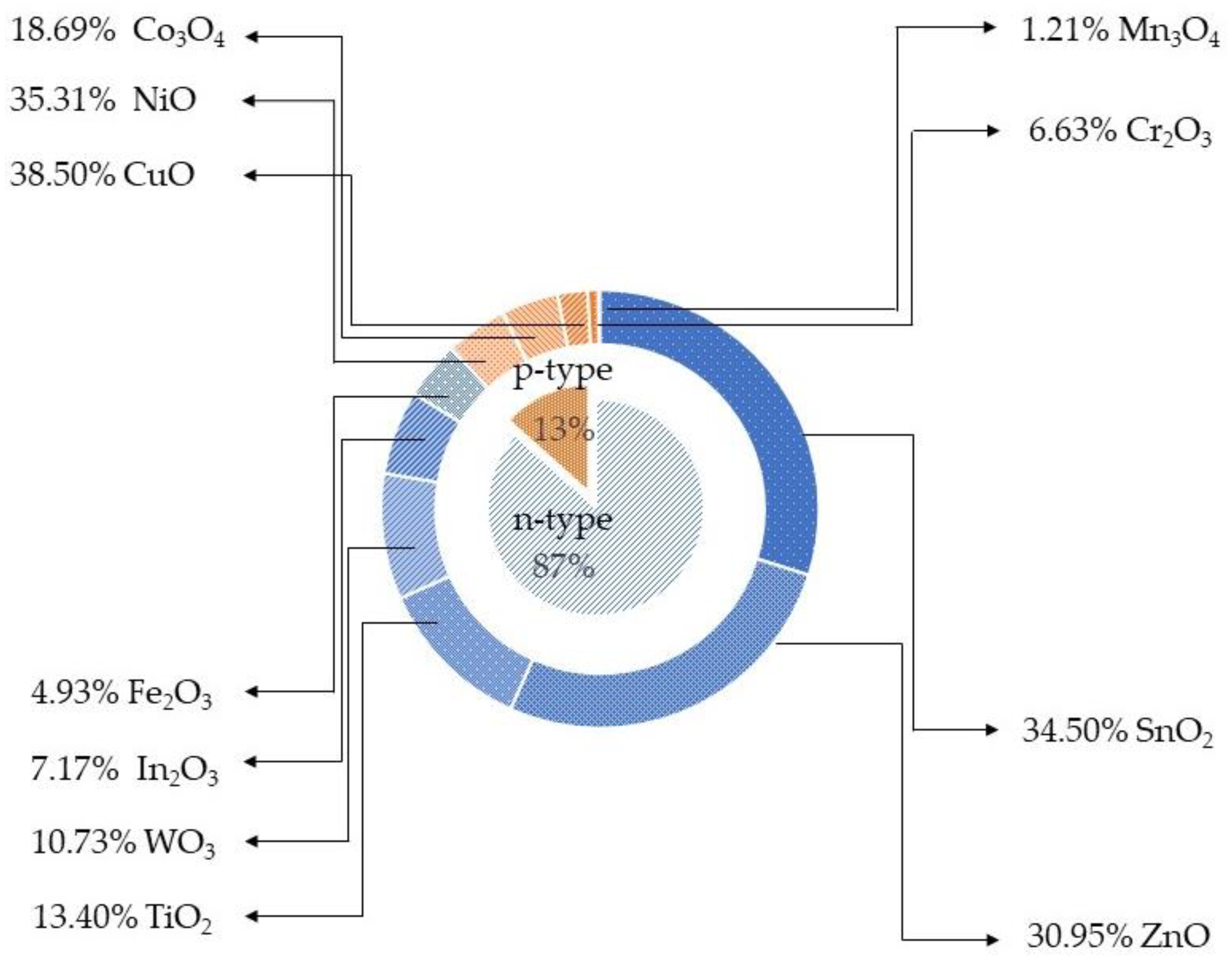
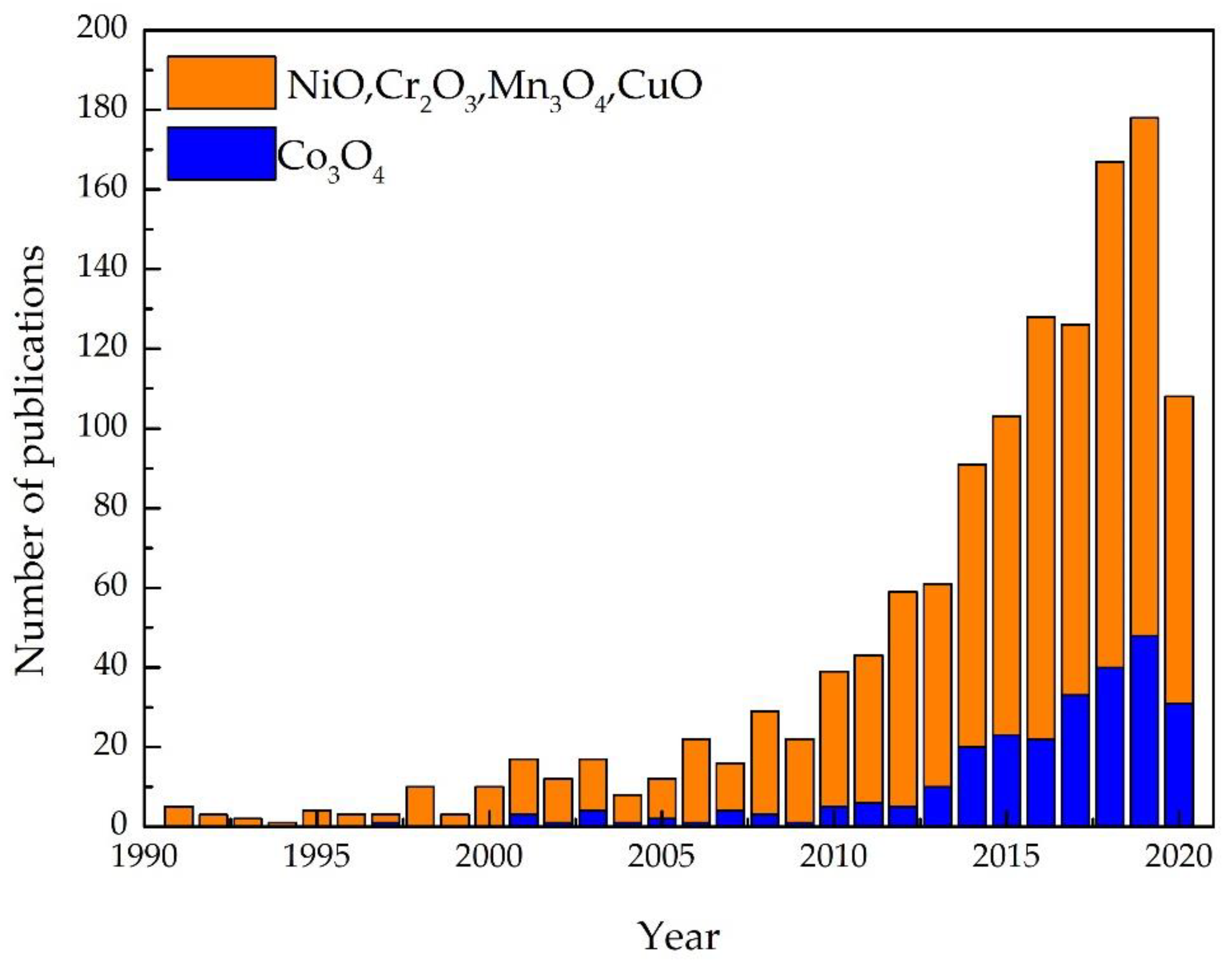
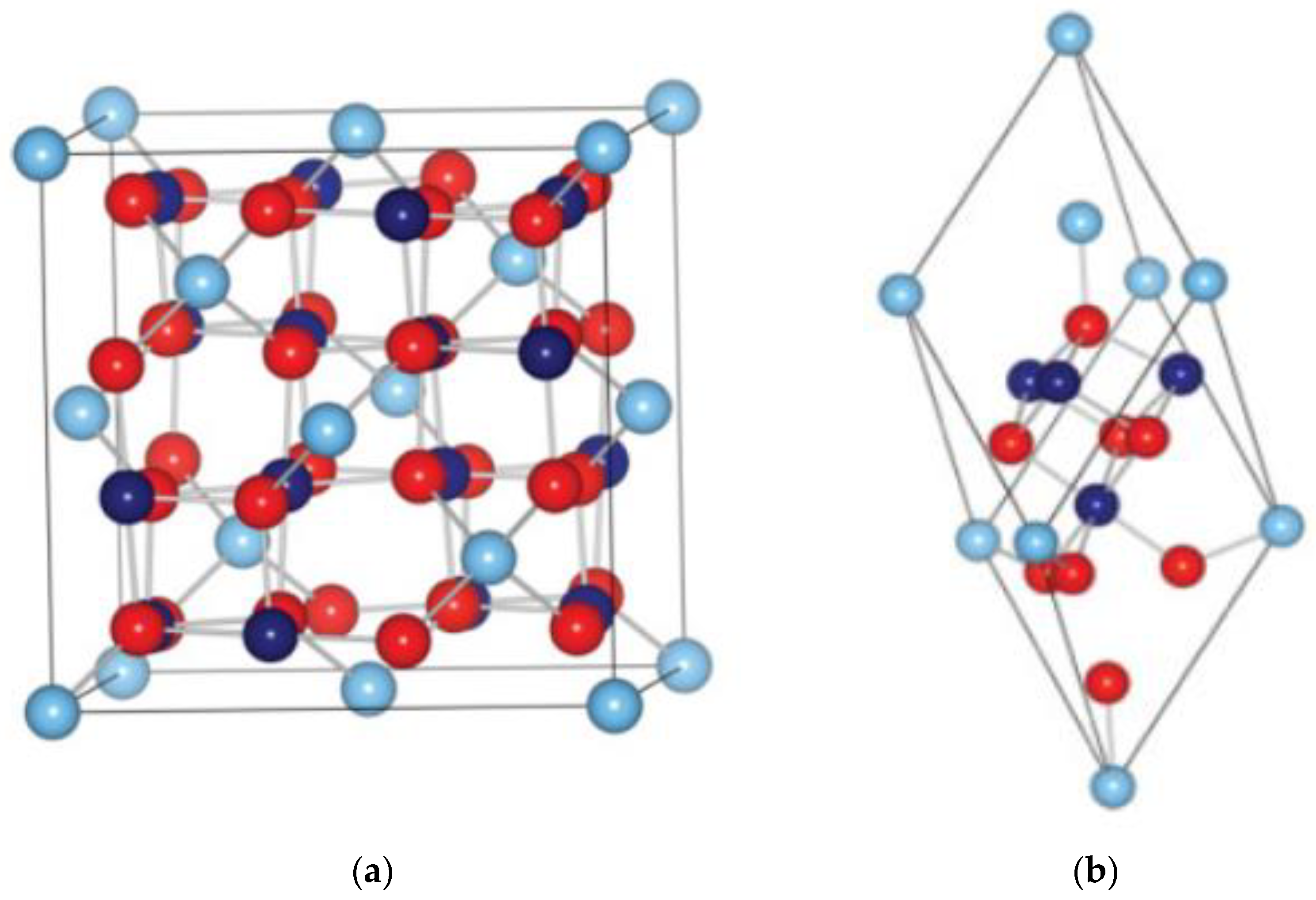
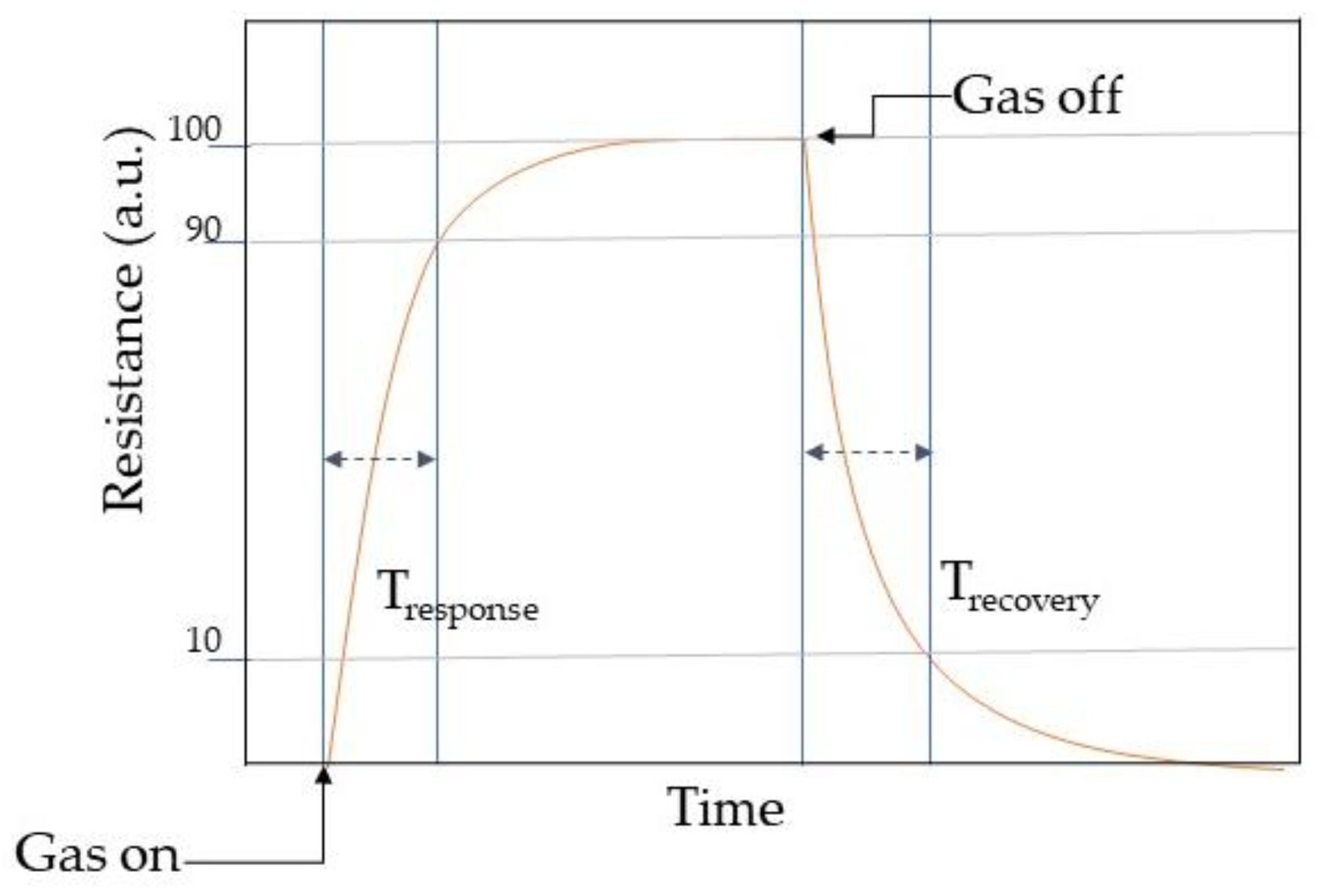
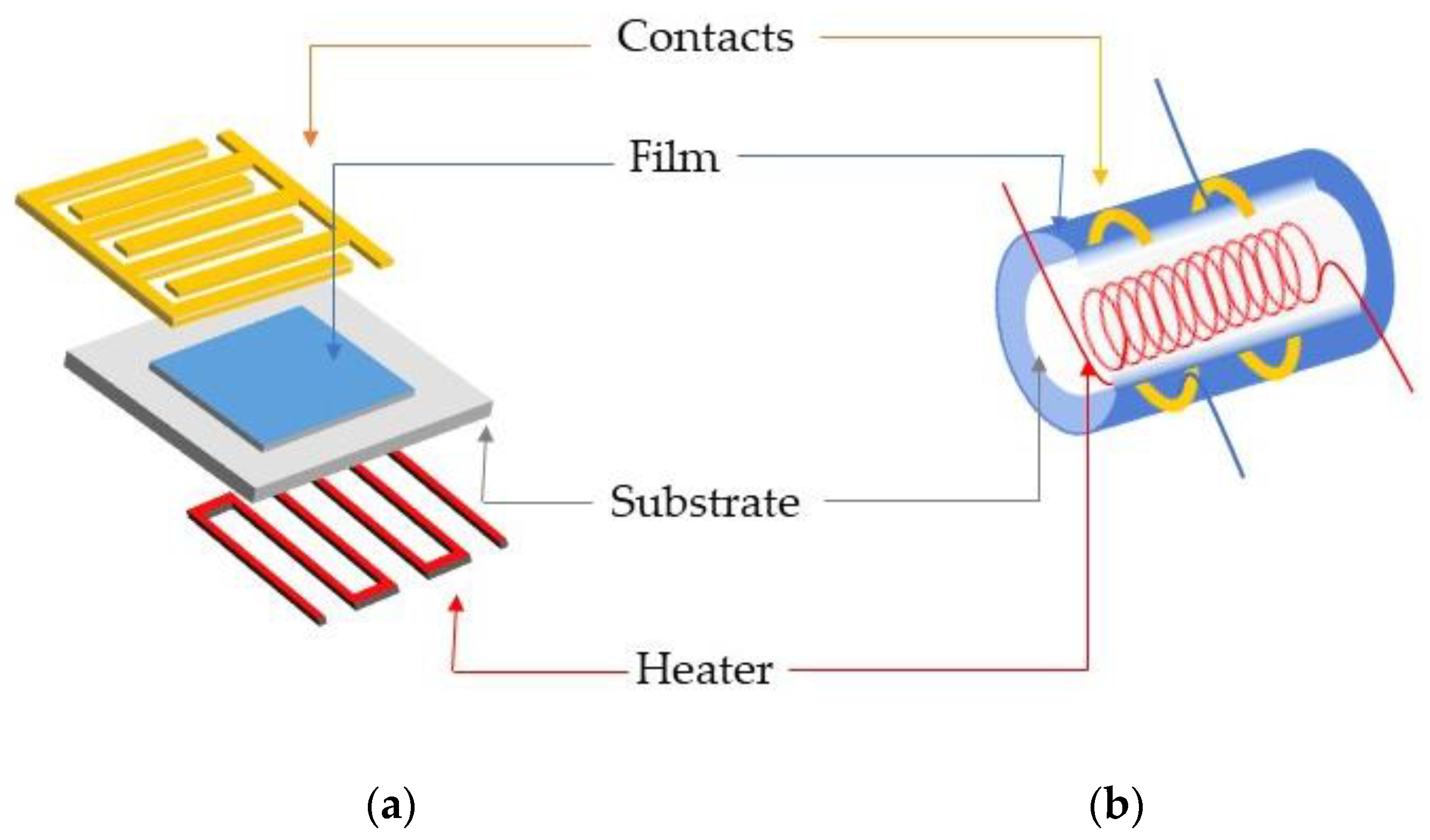
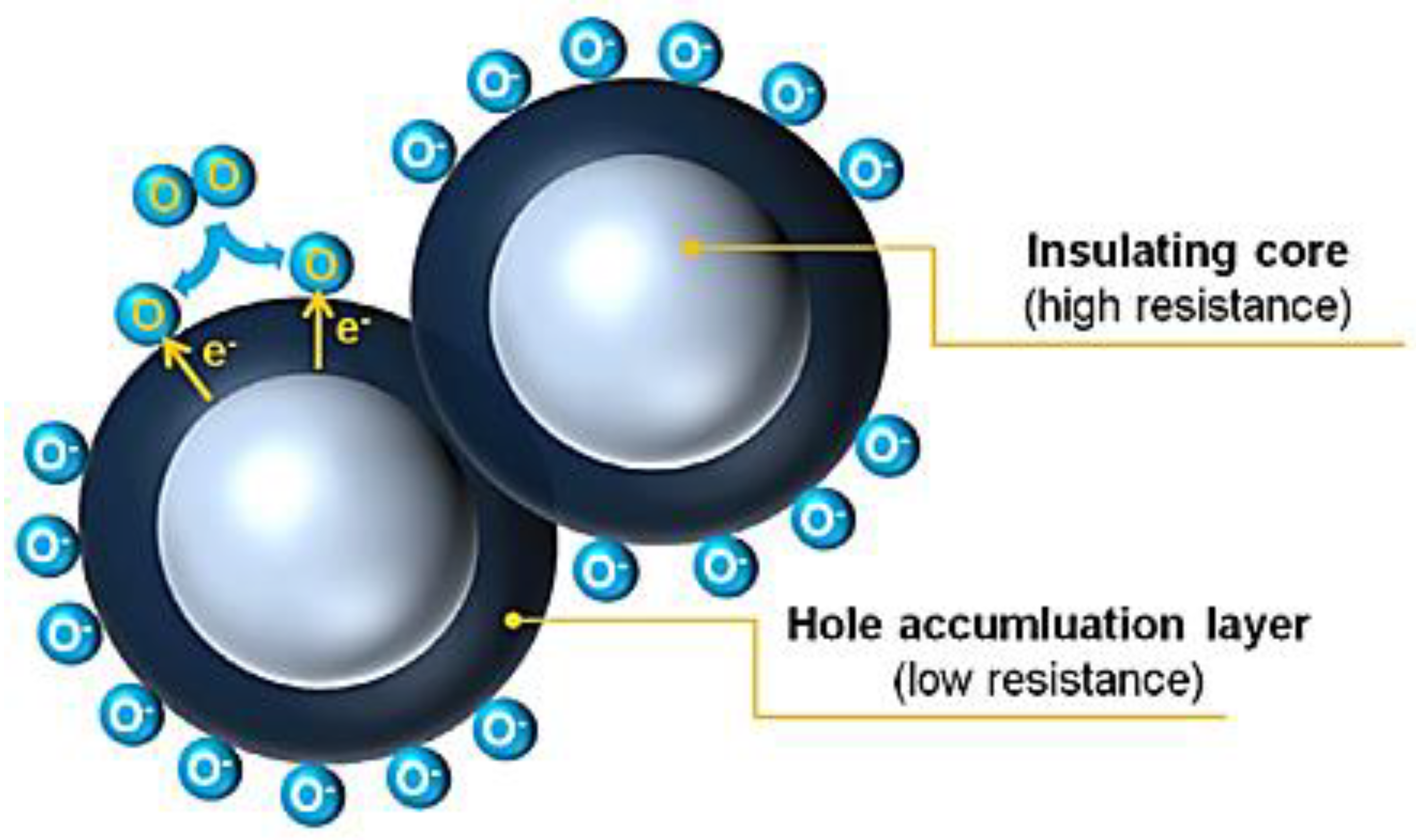
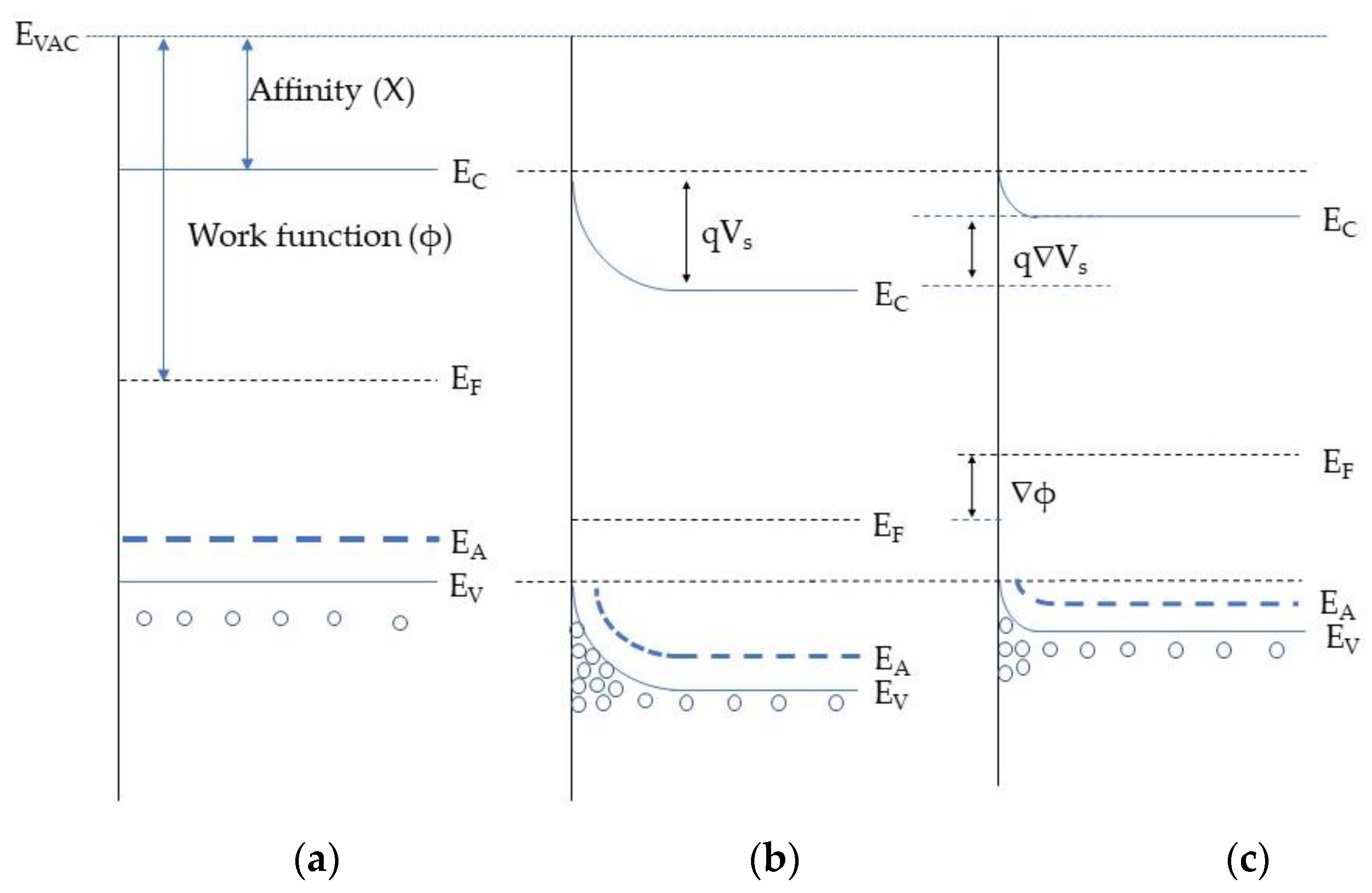
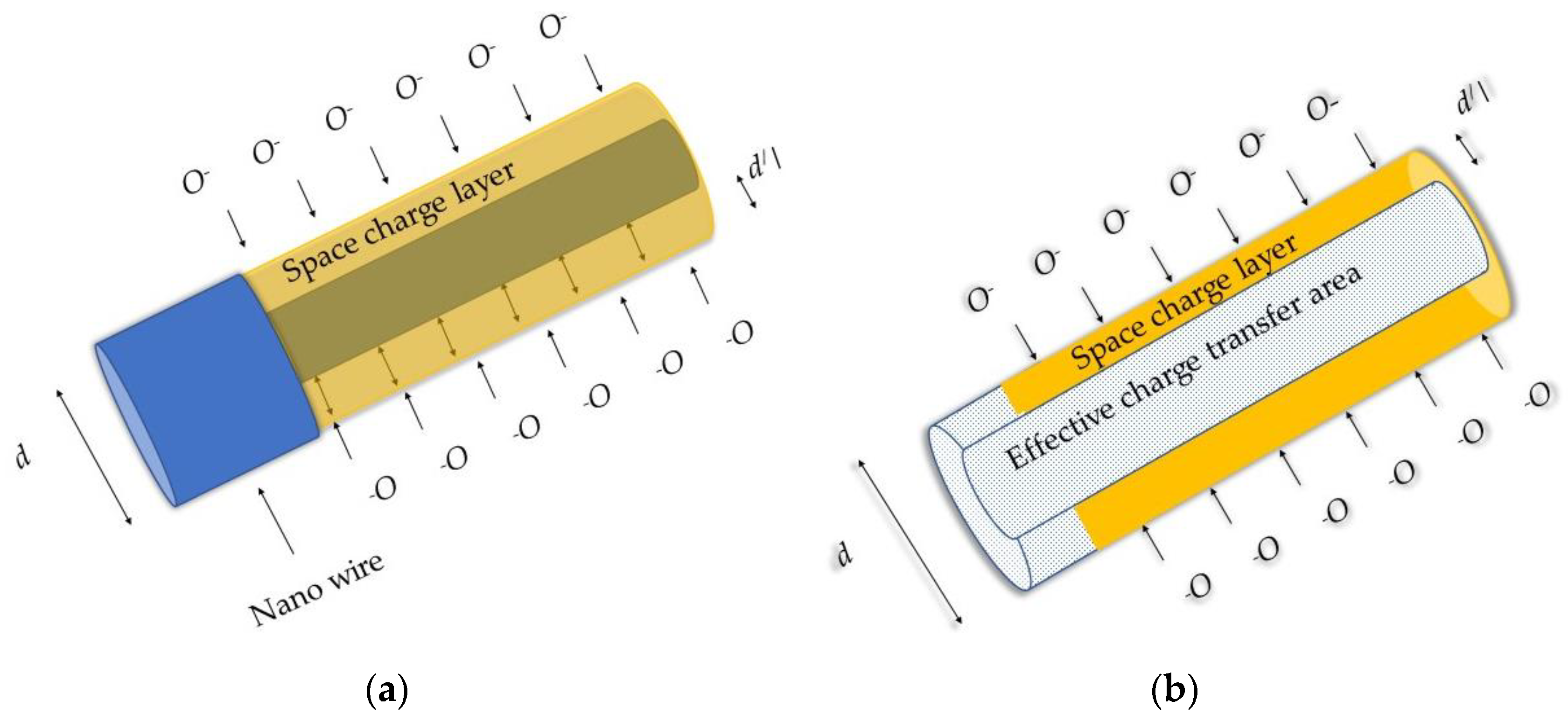


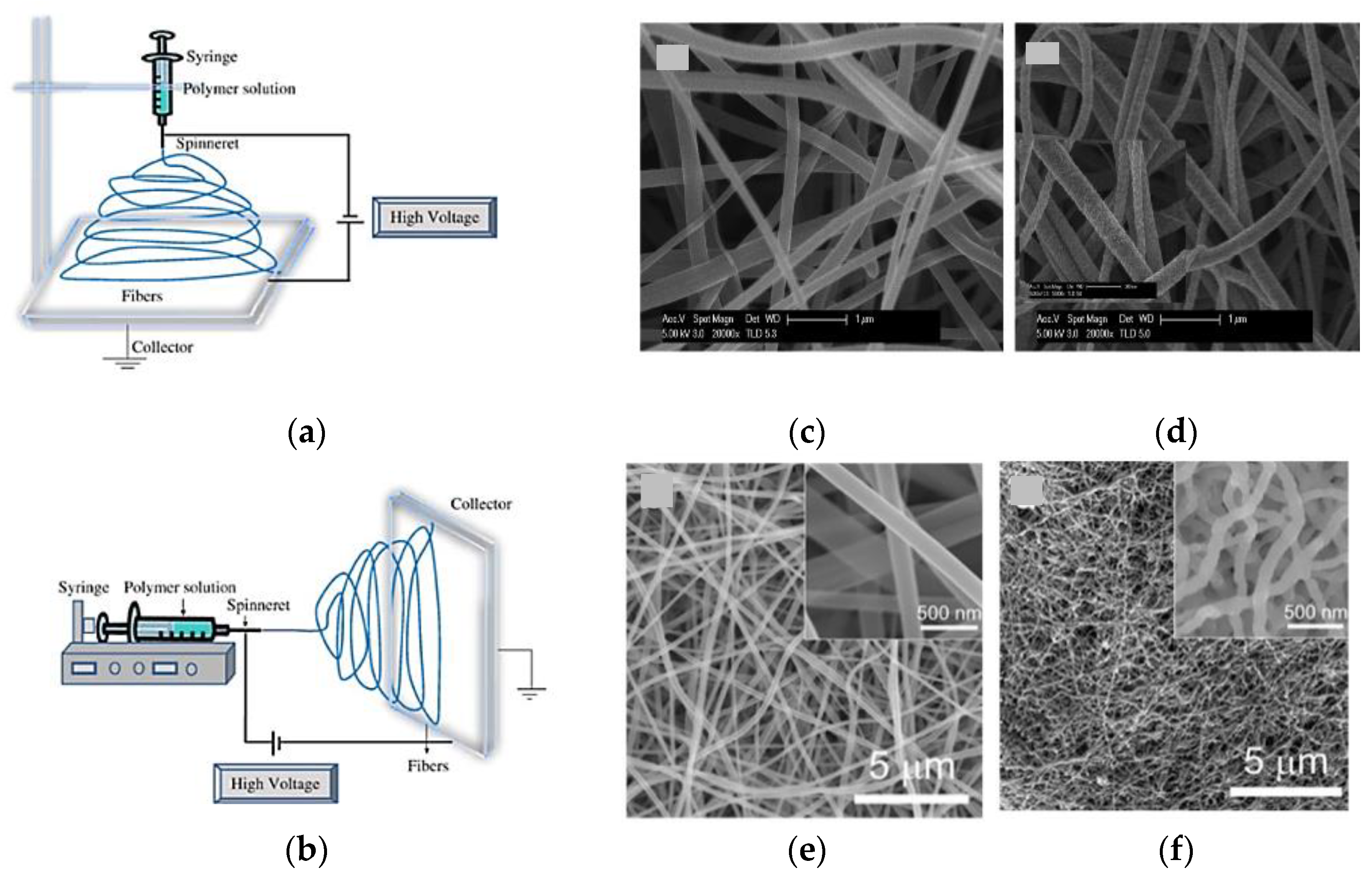
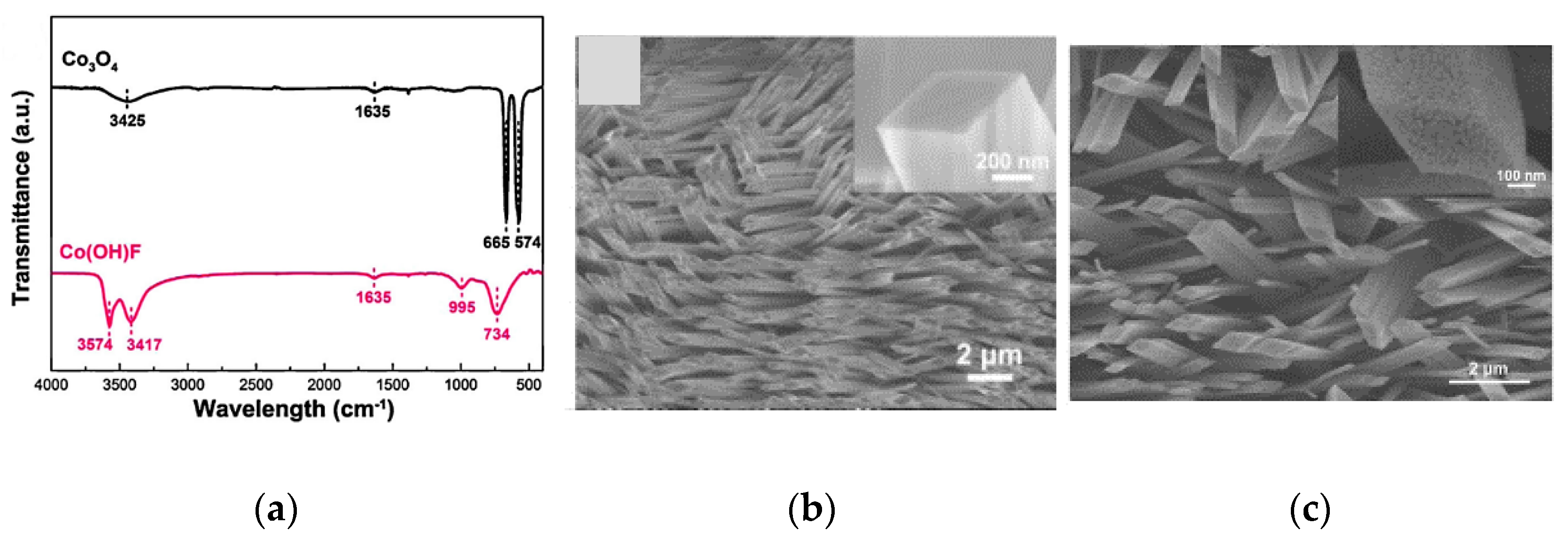
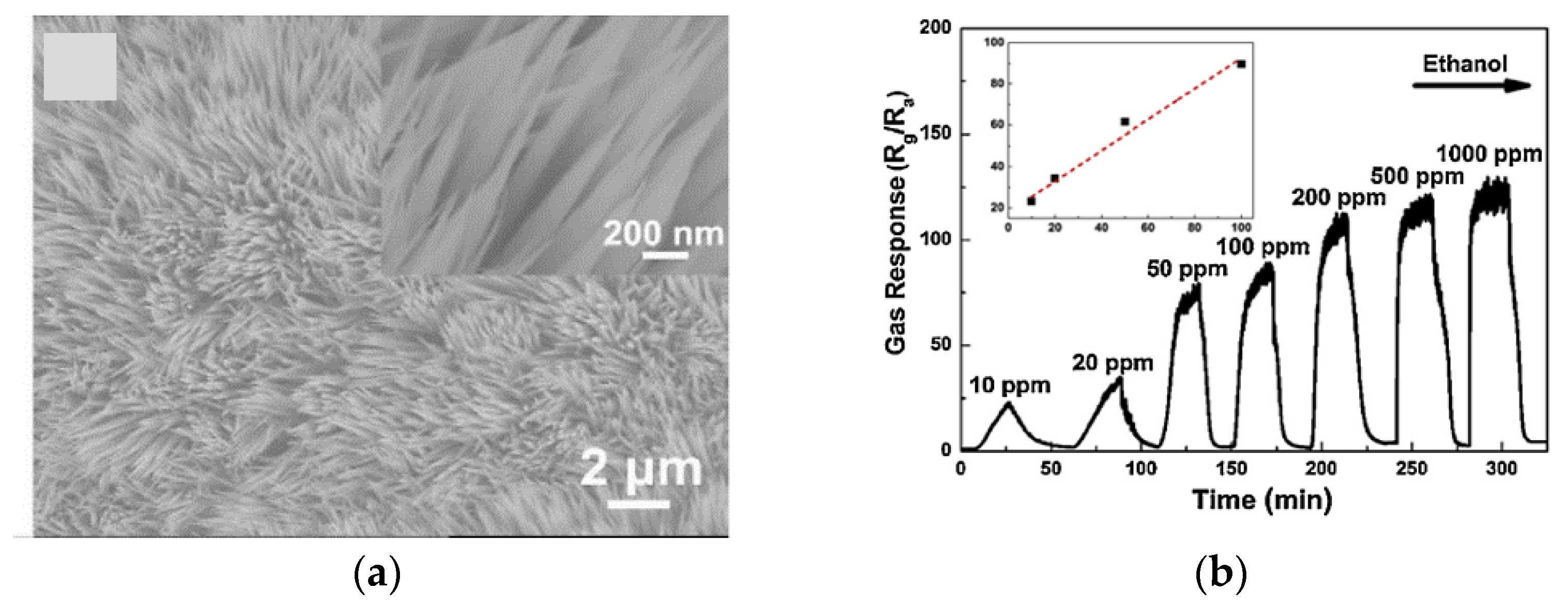
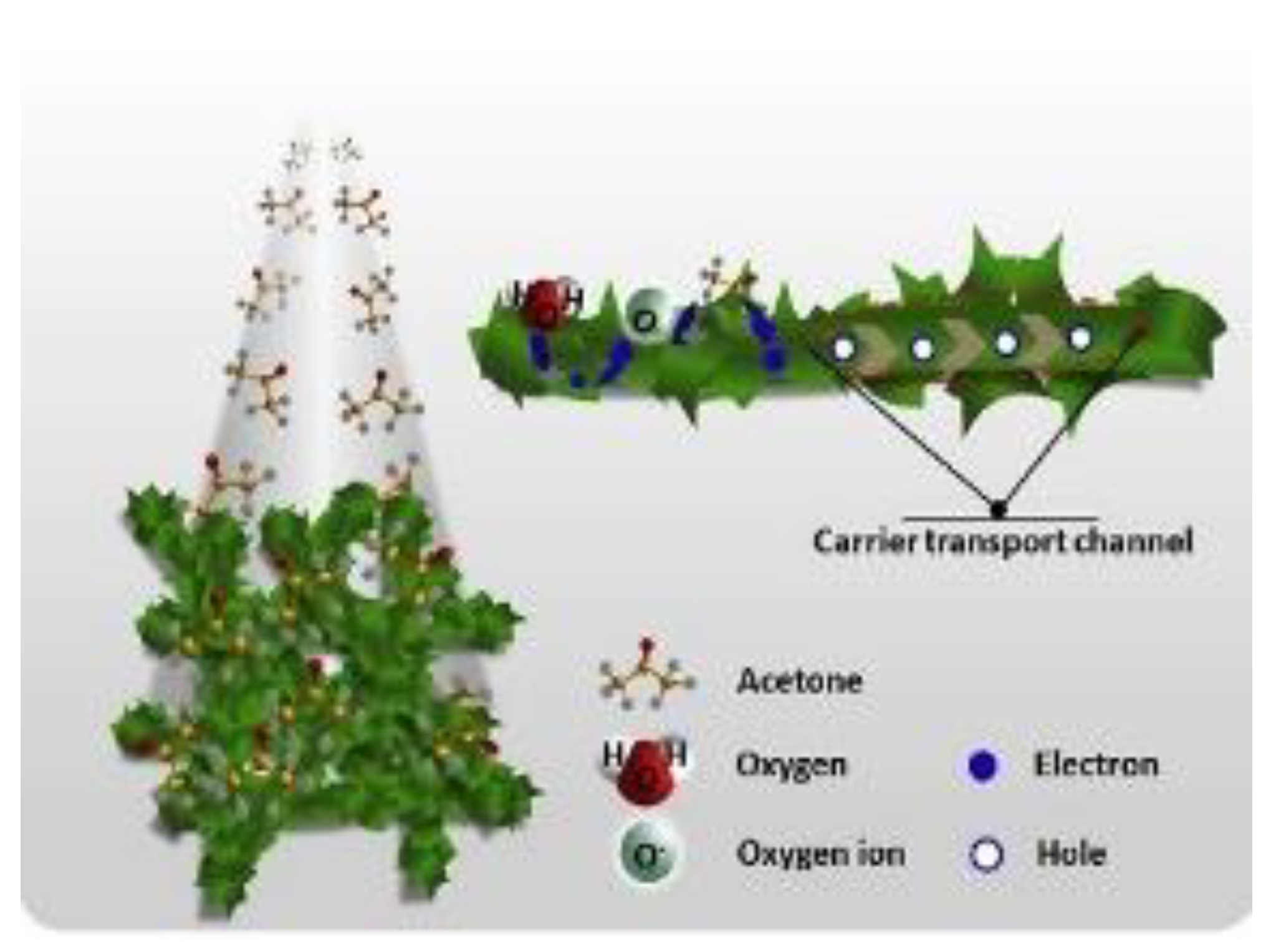

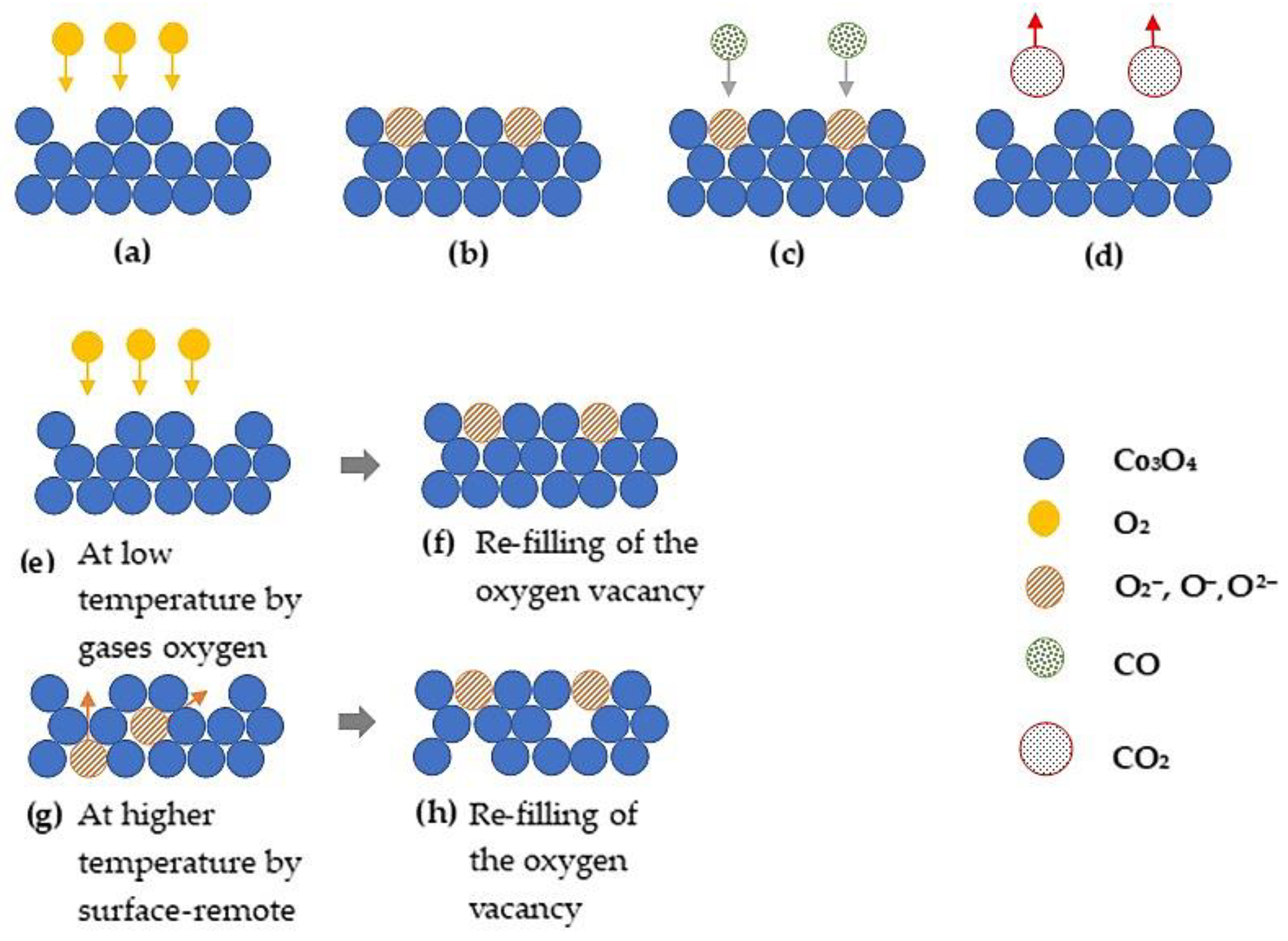
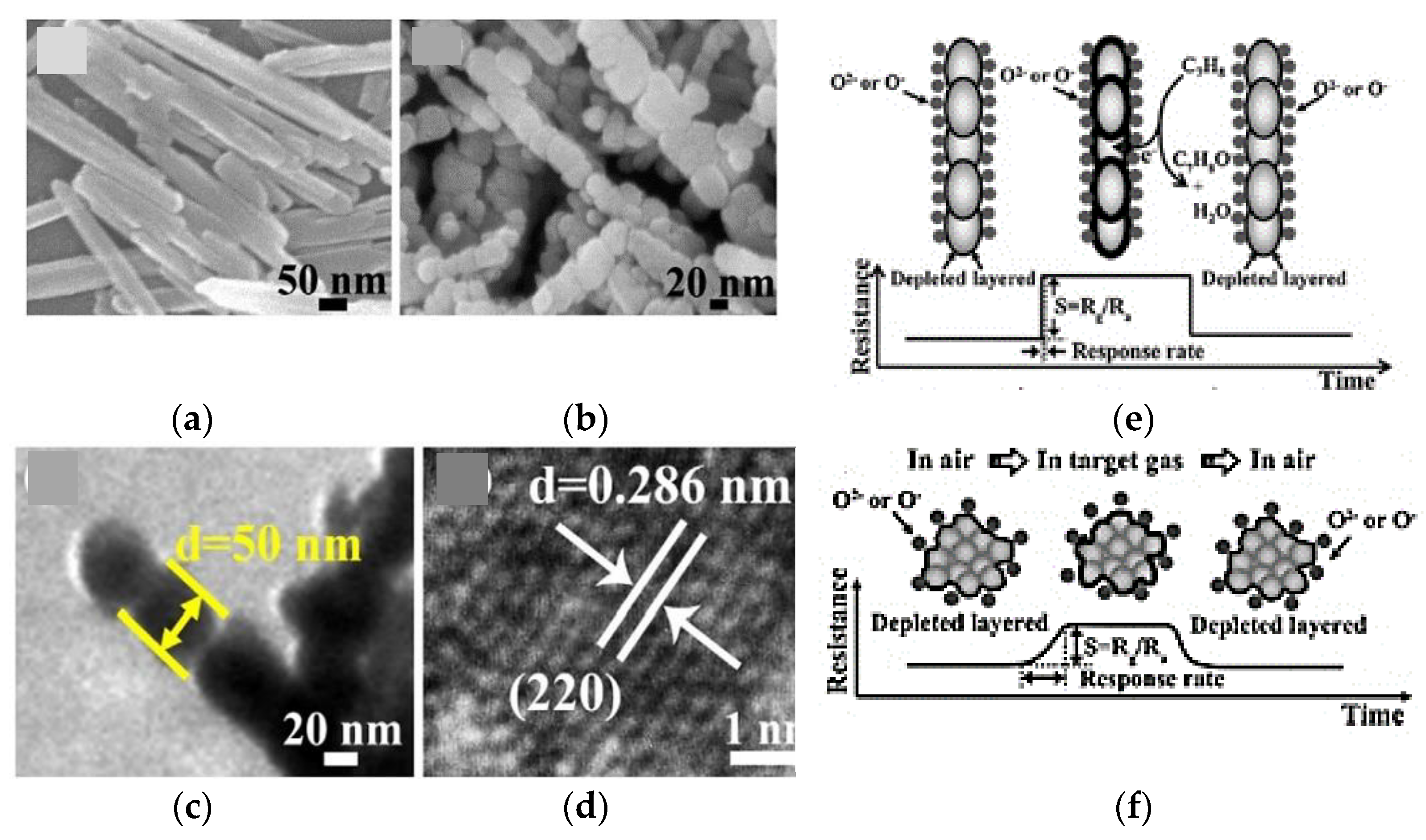

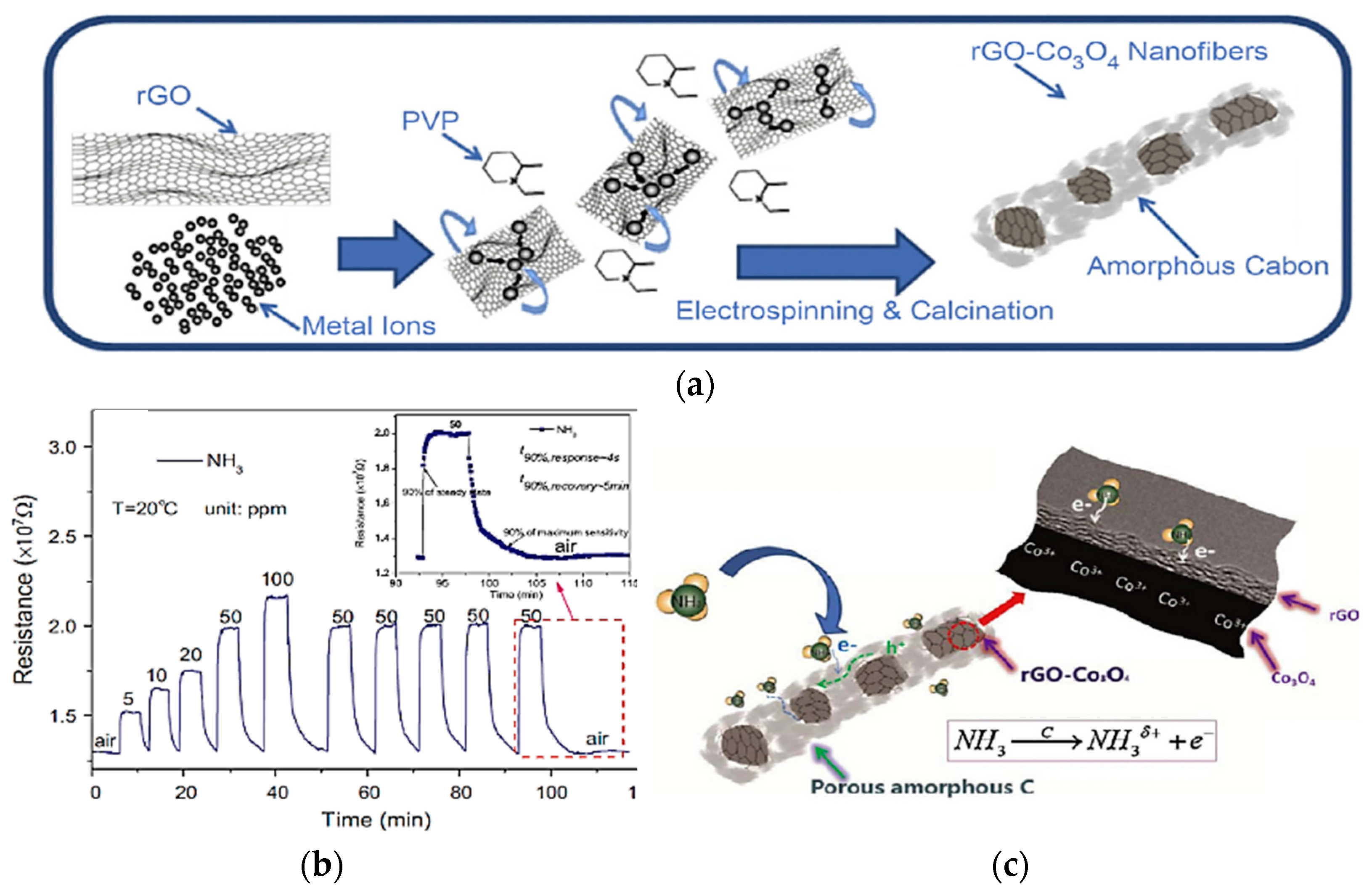


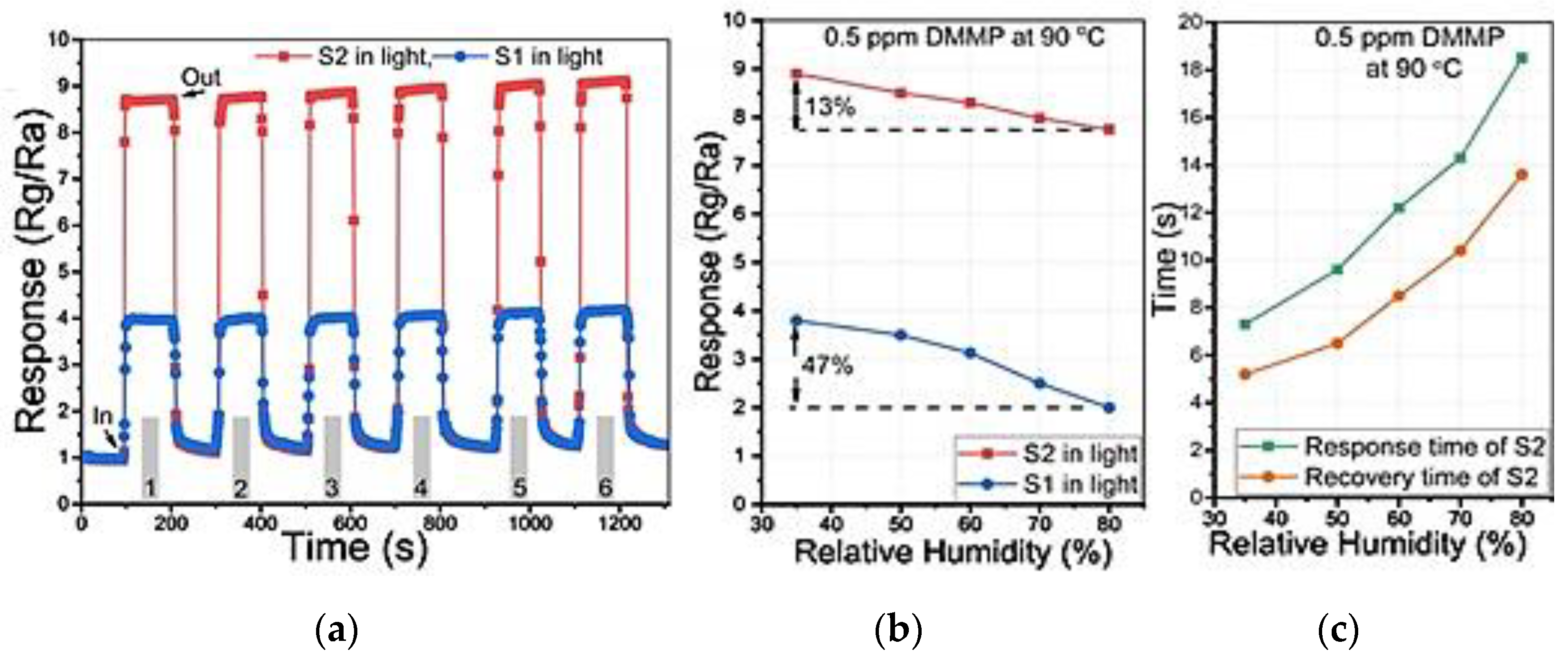
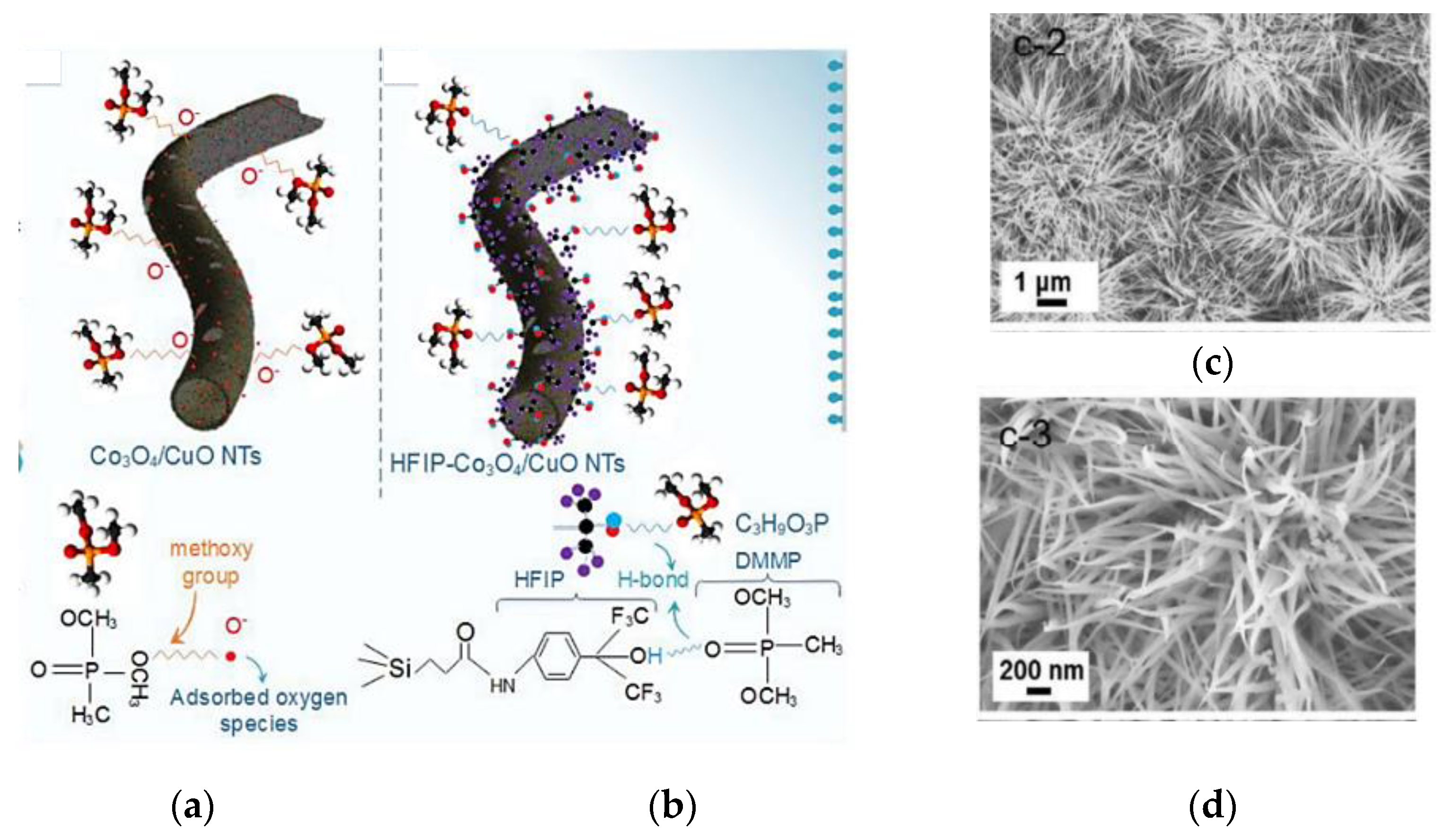
| Metal Oxide | Reducing Gases | Oxidizing Gases |
|---|---|---|
| p-type | Resistance increase | Resistance decrease |
| n-type | Resistance decrease | Resistance increase |
| Co3O4 Morphology | Synthesis Procedure | Analyte Gas | Concentration (ppm) | Top (°C) | Response | Tres (s) | Trec (s) | Reference |
|---|---|---|---|---|---|---|---|---|
| Nanorods | Solvothermal | C2H5OH | 100 | 300 | 25.7 a | 29 | 10–13 | [3] |
| Nanorods | Coprecipitation | CO | 50 | 250 | 6.5 b | NA | NA | [15] |
| Nano wires | Hydrothermal | CO | 20 | 100 | 13.5 b | 62.5 | 100 | [16] |
| Nanowires | Hydrothermal | C6H15N | 100 | 250 | 4 b | NA | NA | [22] |
| Nanowires | Hydrothermal | C3H6O | 150 | 200 | 23 b | NA | NA | [23] |
| Nanorods | Hydrothermal | C3H6O | 74570 | 300 | 18.5 c | 40 | 180 | [24] |
| Rhombus shaped nanorod | Hydrothermal | C2H5OH | 500 | 160 | 71 b | 90 | 60 | [25] |
| Nanorods | Solvothermal | C7H8 | 200 | 200 | 35 b | 90 | 55 | [27] |
| Nanorods | Hydrothermal | (C2H5)2O | 100 | 160 | 110.34 c | NA | NA | [30] |
| Nano needles | Hydrothermal | C2H5OH | 130 | 100 | 89.6 b | NA | NA | [34] |
| Hierarchical Nanofiber | Hydrothermal | C3H6O | 100 | 190 | 9.3 b | 7 | 1 | [52] |
| Hierarchical nanorods | Hydrothermal | NH3 | 100 | 160 | 11.2 b | 2 | 10 | [53] |
| Cr-doped nanorods | Solvothermal | C7H8 | 5 | 250 | 17 b | NA | NA | [59] |
| C8H10 | 18 b | NA | NA | |||||
| Nanofiber | Electrospinning | CO | 5 | 100 | 2.4 b | 14 | 36 | [62] |
| Nano Fiber | Electrospinning | C2H5OH | 100 | 300 | 22.1 b | NA | NA | [63] |
| Nano Fiber | Electrospinning | C2H5OH | 100 | 301 | 51.2 b | 16 | 8 | [65] |
| Composite nanofiber | Electrospinning | C3H6O | 5 | 300 | 2.29 b | NA | NA | [66] |
| Nano Fiber | Electrospinning | C8H10 | 100 | 255 | 10.6 a | 15 | 22 | [67] |
| Nano chains | Hydrothermal | H2S | 100 | 300 | 4.3 b | 46 | 24 | [68] |
| Nano tubes | Facile solution route | HCHO | 50 | 180 | 6.3 b | 3 | 1 | [69] |
| Co3O4/CuO nanotubes | Electrospinning | C3H2F6O | 0.5 | 90 | 8.8 b | 7.3 | 5.2 | [70] |
| Composite nanofiber | Electrospinning | NH3 | 50 | RT | 53.6 c | 4 | 300 | [71] |
Publisher’s Note: MDPI stays neutral with regard to jurisdictional claims in published maps and institutional affiliations. |
© 2021 by the authors. Licensee MDPI, Basel, Switzerland. This article is an open access article distributed under the terms and conditions of the Creative Commons Attribution (CC BY) license (https://creativecommons.org/licenses/by/4.0/).
Share and Cite
Kumarage, G.W.C.; Comini, E. Low-Dimensional Nanostructures Based on Cobalt Oxide (Co3O4) in Chemical-Gas Sensing. Chemosensors 2021, 9, 197. https://doi.org/10.3390/chemosensors9080197
Kumarage GWC, Comini E. Low-Dimensional Nanostructures Based on Cobalt Oxide (Co3O4) in Chemical-Gas Sensing. Chemosensors. 2021; 9(8):197. https://doi.org/10.3390/chemosensors9080197
Chicago/Turabian StyleKumarage, Gayan W. C., and Elisabetta Comini. 2021. "Low-Dimensional Nanostructures Based on Cobalt Oxide (Co3O4) in Chemical-Gas Sensing" Chemosensors 9, no. 8: 197. https://doi.org/10.3390/chemosensors9080197
APA StyleKumarage, G. W. C., & Comini, E. (2021). Low-Dimensional Nanostructures Based on Cobalt Oxide (Co3O4) in Chemical-Gas Sensing. Chemosensors, 9(8), 197. https://doi.org/10.3390/chemosensors9080197







